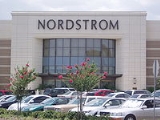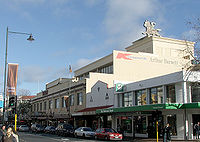
Anchor store
Encyclopedia

Retail
Retail consists of the sale of physical goods or merchandise from a fixed location, such as a department store, boutique or kiosk, or by mail, in small or individual lots for direct consumption by the purchaser. Retailing may include subordinated services, such as delivery. Purchasers may be...
, an anchor store, draw tenant, anchor tenant, or key tenant is one of the larger stores in a shopping mall
Shopping mall
A shopping mall, shopping centre, shopping arcade, shopping precinct or simply mall is one or more buildings forming a complex of shops representing merchandisers, with interconnecting walkways enabling visitors to easily walk from unit to unit, along with a parking area — a modern, indoor version...
, usually a department store
Department store
A department store is a retail establishment which satisfies a wide range of the consumer's personal and residential durable goods product needs; and at the same time offering the consumer a choice of multiple merchandise lines, at variable price points, in all product categories...
or a major retail chain.
When the planned shopping mall format was developed by Victor Gruen
Victor Gruen
Victor David Gruen, born Viktor David Grünbaum , was an Austrian-born commercial architect best known as a pioneer in the design of shopping malls in the United States.- Biography :...
in the mid-1950s, signing larger department stores was necessary for the financial stability of the projects, and to draw retail traffic that would result in visits to the smaller stores in the mall as well. Anchors generally have their rents heavily discounted, and may even receive cash inducements from the mall to remain open. In physical configuration, anchor stores are normally located as far from each other as possible to maximize the amount of traffic exposure for other stores when shoppers walk from one anchor to another.
The International Council of Shopping Centers
International Council of Shopping Centers
Founded in 1957, the International Council of Shopping Centers is the global trade association of the shopping center industry. Its 60,000 members in the U.S., Canada and more than 80 other countries include shopping center owners, developers, managers, marketing specialists, investors, lenders,...
makes the presence of anchors one of the main defining characteristics of the two largest categories of malls, the regional center with 400,000 to 800000 square feet (74,322.4 m²) in gross leasable area
Gross leasable area
Gross leasable area in the retail development industry is a term applied to shopping malls, lifestyle centers, outlet malls and other retail centers to indicate the amount of floor space available to be rented...
, and the superregional center with more than 800000 square feet (74,322.4 m²) of space. The regional center typically has two or more anchors, while the superregional typically has three or more. In each case, the anchors account for 50-70% of the mall's leasable space.
Malls with anchor stores have consistently outperformed those without one, as the anchor helps draw shoppers initially attracted to the anchor to shop at other stores in the mall.

Grocery store
A grocery store is a store that retails food. A grocer, the owner of a grocery store, stocks different kinds of foods from assorted places and cultures, and sells these "groceries" to customers. Large grocery stores that stock products other than food, such as clothing or household items, are...
s were a common type of anchor store, since they are visited often. However, research on consumer behavior revealed that most trips to the grocery store did not result in visits to surrounding shops. As of 2005, the declining popularity of old-line department stores makes it necessary for mall management companies to consider re-anchoring with other retail alternatives, or mix commercial development with residential development to guarantee a captive clientele. The challenges faced by the traditional large department stores have led to a resurgence in the use of supermarkets as anchors.

